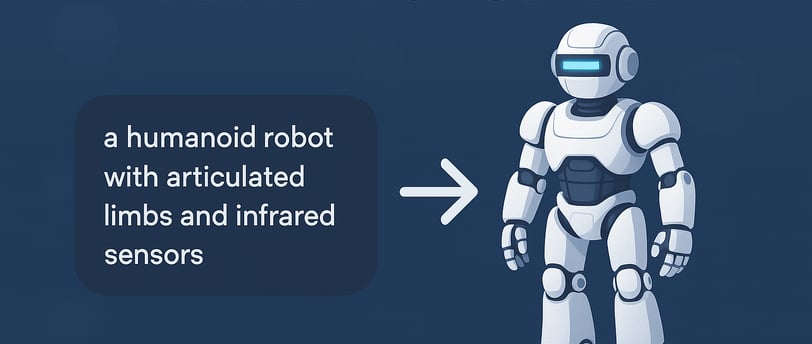Typing Out the Future: How Text-to-3D AI is Shaping the Next Generation of Robots


What if designing a robot didn’t require engineering degrees or CAD software—just a few simple words?
That’s the bold promise behind text-to-3D AI, a cutting-edge technology that turns natural language into complex 3D models, now being used to generate robotic concepts and prototypes.
What Is Text-to-3D AI?
Text-to-3D generation is a subset of generative AI that interprets written prompts and creates 3D visualizations. While it began with basic object modelling, platforms like DreamFusion by Google and OpenAI's Point-E are now being used in more advanced applications, including robot design.
Using AI, you could simply type:
“A humanoid robot with articulated limbs and infrared sensors”
And within seconds, get a visualized 3D model to use in simulations or manufacturing workflows.
How It’s Transforming Robot Development
Rapid Prototyping: Engineers can go from idea to model faster than ever.
Cross-Team Communication: Text-based descriptions reduce misinterpretation between non-technical and technical team members.
Democratizing Design: Individuals and startups can now compete with larger R&D teams.
According to MIT Technology Review, this tech lowers the entry barrier for robotic innovation by allowing anyone to visualise functional components and body structures of robots through language-based prompts.
Use Cases in Robotics
Concept Visualization: Perfect for pitching early-stage robotics ideas to investors.
Training Data Generation: Used in AI-based robotics to simulate different body types and interactions.
Educational Tools: Helps students learn robotics by visualizing mechanisms without needing expensive hardware.
Startups like Kaedim and Luma AI are already leveraging similar tools to accelerate design pipelines, and platforms like Unity or Unreal Engine can import these AI-generated 3D models for animation or testing.
The Bigger Picture
Text-to-3D generation isn’t just a tech trend—it’s a revolution. By combining natural language processing, 3D modeling, and robotics, this innovation paves the way for automated prototyping, custom robot manufacturing, and even AI co-design with humans.
Want to experiment with this tech? Explore Sloyd.ai or Shap-E by OpenAI, which provide open-source models and real-time generation tools
At Digital Ambassador, we believe the future of robot design is just a sentence away. Follow us for more insights into how AI and automation are reshaping the digital frontier.
